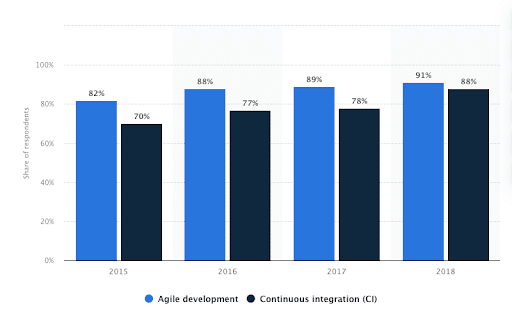In this day and age, “software development team structure” is practically synonymous with “agile team structure.”
This has been the case for quite some time. A whopping 91% of organizations worldwide had adopted agile development principles as early as 2018.

But the question is, what do such numbers mean for you?
Simply that, if you want to build a high-performing development team in 2022 and beyond, you need a solid understanding of agile methodologies on the one hand and how to properly structure an agile team on the other.
In this article, we focus on the latter.
Here is how to ensure that your software development team structure is the right fit for your needs.
What We Mean When We Talk About Development Team Structure
Agile teams come in different shapes and sizes. Popular types of team structures include:
Generalist Teams
Generalists are experienced in multiple phases of the software development lifecycle, from design and coding through testing and deployment. They work on various tasks, often juggling workflows simultaneously, and can switch roles and projects or step in for a colleague as needed. An example is full-stack developers working on both the front and back end of applications. The generalist approach is better suited for smaller teams and projects.
Specialist Teams
Specialist developers have extensive experience and in-depth insight into a particular field. All members of a specialist team have distinct roles based on their skills and expertise and are solely responsible for tasks within that niche. This development team structure typically works best for big organizations with enough headcount to dedicate to all relevant practice areas.
Hybrid Teams
Hybrid teams give you the best of both worlds. They have specialists zeroing in on specific tasks or development stages as well as generalists looking out for the big picture. This team structure is the most flexible of all and is ideal for complex projects that require different types of expertise.
Multi-Tiered Teams
As the name suggests, multi-tiered teams consist of multiple smaller teams working on different parts of the software development process. A multi-tiered structure is particularly useful for breaking down large projects into more manageable pieces.
To dive deeper into this topic, read our blog post on How to Build an Agile Development Team Structure in 2022.
Factors to Consider When Choosing a Software Development Team Structure
How you set up your agile development team — and whether that structure is appropriate for your project and organization – plays a crucial role in the success of the software product.
Here are five factors that will help you gauge which of the models above is best suited for your needs:
1. Project Type
Your first point of reference is always the project requirements. The more complex and larger the undertaking, the likelier it is that it could benefit from specialist input.
For instance, a few generalists will typically suffice to build a simple e-commerce platform. However, if you are developing a new application complete with third-party integrations and multiple features, you likely need specialists on board.
Also, remember that just because the project requires some in-depth expertise does not automatically mean a specialist team is the right choice. This team structure is notoriously resource-intensive. A hybrid team can deliver the expertise you need without eating up too many resources if you are operating with a limited budget or a small headcount.
2. Collaborative Processes
For all their flexibility, hybrid and multi-tiered teams may experience communication issues due to the different profiles of their developers. If speed and ultra-smooth collaboration are important to you, that may be an issue.
Heterogeneous team structures can also create dependencies among team members that would otherwise work in isolation. This further complicates project management, as you may have to appoint a separate product manager to oversee collaborative processes.
Alternatively, you need to have broad expertise across product development yourself — think design, coding, industry knowledge, marketing, etc. — to coordinate your software developers and help prevent communication gaps.
3. Team Member Locations
If your developers are scattered across time zones, avoid agile methodologies and team structures that require full synchronization, constant communication, and real-time collaboration.
Cross-functional teams with specialists and generalists working on different parts of the product would be a better option instead. You could also consider a multi-tiered team with members of the same subteams in the same time zones.
4. The Time Frame
The project time frame in combination with your budget, which we discuss below, will largely determine how many software engineers you hire and at what level of seniority.
If you are working under a tight deadline, you may want to hire more senior engineers and a dedicated project manager to get the job done quickly. This usually means adopting a specialist approach.
But if you have more time, you could explore more flexible (and more affordable) hybrid structures in which juniors collaborate with and learn from senior engineers.
5. Budget
Last but not least, you have the financials to think about. The size of your budget will affect many, if not most, decisions, including which locations to hire in, the seniority of the developers, how many people per team there will be, the technologies and tools to be used, and more.
A smaller budget may mean hiring generalists instead of specialists unless you are under time pressure. In contrast, a more generous budget usually enables you to build a specialist, hybrid, or multi-tier team.
Common Mistakes to Avoid When Structuring Your Development Team
The don’ts are just as important as the dos if you want to set your agile software development team up for success. Try not to make these all-too-common mistakes, and life is easier:
Underestimating Project Management Needs
Depending on its size and complexity, your project may require oversight from a project or a product manager.
Unfortunately, many organizations underperform in day-to-day operations due to either a lack of a dedicated manager or insufficient clarity around processes, responsibilities, and delegation. For instance, companies working with Scrum often delegate too much to the Scrum master instead of appointing a separate product or project manager.
Poor Resource Estimation
Some project and product managers will try to squeeze as much value out of the project timeframe as possible. As a result, they end up underestimating the workload, their teams’ capabilities, and what deliverables should look like. Putting pressure on the team to deliver without providing adequate resources is a surefire way to fail.
Failed Communication and Collaboration
With most of us all working remotely these days, there need to be clear steps for handover and information-sharing among team members for communication to flow smoothly. A lack of comprehensive documentation, proper handover processes, and project management tools, as well as both insufficient and overcommunication, create unnecessary interdependencies and cause teams to waste time, money, and resources.
Need Help Identifying the Right Development Team Structure?
There is no “ideal” agile team structure. What works great for some development projects might not work nearly as well for yours.
To complicate things further, there are many factors to consider when choosing the most appropriate set-up for your needs.
But the good news is that you are not alone. Here at Zartis, we specialize in building bespoke dedicated development teams for clients worldwide.
We will carefully tailor your agile software development team to your technical requirements, existing systems, and business goals to ensure that your product will be a success.
To get started, simply write us a message to tell us more about your organization and your project. We will be in touch shortly.

